How to design a high-impact community offering
Think about the last time you joined a community. You didn’t opt in just because—you joined because you believed that the community would help you achieve something that matters to you.
And your community members? They’re no different.
- Maybe they want someone to hold them accountable as they work towards a specific goal.
- Maybe they want access to tools and insider knowledge that will allow them to level up in their career.
- Maybe they just want to connect with like-minded people.
People only join communities that they believe will be valuable to them. Which means that, as a community builder, one of your very first (and most important!) jobs is to define exactly how you’ll provide value through your community—whether you’re designing a community strategy from scratch, or refining an existing approach.
Your community offering is how you deliver that value to members. So let's get clear on what a community offering is, and explore effective online community offering design strategies for your community.
Why does your community offering matter?
Thriving communities aren’t built by accident—they’re meticulously designed. And your community offering is the backbone of that design.
Building an online community isn’t just about creating a few random spaces and calling it a day. It’s about figuring out what you can offer in your community to effectively move members through real and lasting transformation.
Easy-peasy, hey?
When your offering actually delivers true transformation, some magical things start to happen:
- Members engage more easily: Instead of wondering where to start or how to get involved, members see clear opportunities to participate and act on those — whether that’s joining a live event, finding the perfect resource, connecting with peers, or all of the above.
- Members stick around and become advocates for the community: When your community delivers real value, members are more likely to stick around, refer others, and become champions that help nurture your flywheel.
- Your community becomes easier to market: When you have a clear offering in place, it’s easier to articulate the unique benefits of your community. This makes your community more compelling to potential members, and can help you stand out in a crowded space.
There are a lot of benefits to nailing your community offering, but engagement is arguably the most important one. Because when your offering is truly aligned with what your members want and need, you won’t have to rely on engagement “hacks” or false urgency to get them to stick around — they just will.
So, let’s take a closer look at the three categories that make up a strong community offering.
3 key components of every high-impact community offering
The strongest community offerings are made up of experiences, resources, and connection opportunities. Before we move forward, let’s take a moment to define each of those terms:
- Experiences are structured activities, events, or programs designed to help members to learn, grow, and engage as they make progress toward their goals.
- Resources are content, tools, and materials that provide members with proven strategies, frameworks, and guidance they can apply to their own journey.
- Connection opportunities are chances for members to build meaningful relationships, support others, and feel a sense of belonging within the community.
The most successful communities don’t just offer one or two of these — they offer a strategic mix of all three.
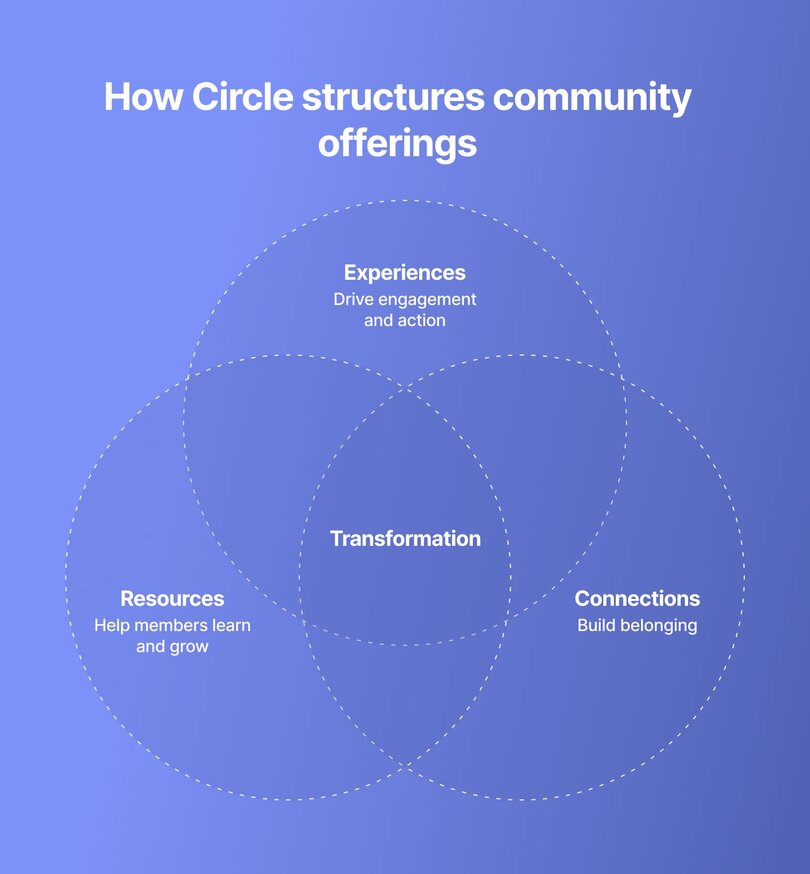
That mix doesn’t necessarily need to be equally balanced across the three categories, however. What’s most important is finding an intentional way to include all three categories, while indexing most on the category that’s going to drive the greatest transformation for your members.
E: Experiences that drive engagement and action
Community experiences are the heartbeat of your offering—the structured activities, events, or programs designed to help members to learn, grow, and engage as they make progress toward their goals. These are invaluable because they can provide members with much-needed structure and accountability, which gives members a reason to keep coming back.
Experiences can take many different forms — but to get you started, here are just a few ideas of experiences you can include in your offering mix.
Live events
Live events bring members together in real time and allow them to participate in a shared experience together. This might look like group coaching, hot seat, or office hours sessions; expert Q&A or AMA sessions; accountability or coworking sessions; or even skill-building workshops.
Structured activities
Structured activities provide members with the structure, accountability, and consistency needed to achieve a specific goal or outcome. These can include challenges, contents, sprints, and cohort-based courses.
Async discussions
Asynchronous discussions provide a flexible, low-effort way for members to participate, stay connected, and experience the value of the community. To encourage these discussions, you can share prompts and thought starters, build spaces where members can share their progress and learnings, or offer opportunities for members to share their wins with the rest of the community.
R: Resources that help members grow on their own time
Resources are the content, tools, and materials that provide members with proven strategies, frameworks, and guidance they can apply to their own journey. They equip members to take action and provide immediate practical value since members can access them at any time.
Here are several examples of resources you might include in your offering mix.
Resource library
A resource library serves as a dedicated space where members can access curated templates, tools, and materials to support them in their journey. In your community’s resource library, you might include templates and worksheets, guides, checklists, case studies or member spotlights, community content roundups, or tool/product recommendations.
Video library
An on-demand video library can give members another way to tap into the value of the community in their own time. In your video library, you might upload replays of past events, tutorials, or even video interviews.
Evergreen courses
Finally, evergreen courses can offer members a step-by-step learning experience, seamlessly guiding them from Point A to Point B. You can create several different types of courses in Circle, including self-paced, structured, and scheduled courses.
C: Connection opportunities that build belonging
Connection opportunities are chances for members to build meaningful relationships, support others, and feel a sense of belonging within the community.
Unlike experiences, which offer structured opportunities to take action, and resources, which provide on-demand value, connection is all about relationships — the conversations, interactions, and moments of support that make members feel like they belong, and inspire them to return again and again.
Below are just a few examples of connection opportunities you might include in your offering.
Peer support
Carving out spaces for peer support gives members the chance to turn to others on the same journey for guidance. Peer support can take different forms, but it might look like creating spaces where members can ask questions or share their challenges, celebrate their wins and success, or even connect with others via real-time chat.
Member matching
Matching or grouping members together allows them to build lasting relationships with others in the community. Member matching can take the form of one-on-one pairs, small groups or cohorts, or even dedicated mastermind groups.
Connection-focused onboarding
Finally, centering the new member onboarding experience around connection can help new community members feel seen, valued, and ready to engage. To achieve this, you might create a space where members can introduce themselves, assemble a welcome committee to greet new members, or host a small group onboarding call to get new members up to speed.
Finding the right offering mix for your community
Every community has a unique offering mix.
Some prioritize live events and interactive experiences, while others are focused on providing members with the resources they need to succeed on their own time. Some communities center around meaningful peer-to-peer connection, while others serve as hubs for exchanging knowledge and expertise.
The most important thing to keep in mind as you start to design your mix is that there’s no right answer or foolproof formula. Your mix should be unique to your community, and it should align with your community’s purpose, your goals, and your members’ wants and needs.
The type of community you run can cue you in on what to prioritize::
- Premium coaches might emphasize experiences (live coaching calls, hot seats) and connection (exclusive peer networking) to justify high-ticket pricing
- Course creators might lean heavily into resources (video libraries, templates) and experiences (structured challenges, cohorts) to drive completion rates
- Professional organizations could balance resources (industry content, continuing education) with connection (member networking, committees) for retention
- Aspiring entrepreneurs sometimes start connection-heavy (peer support, accountability) while building their resource library over time
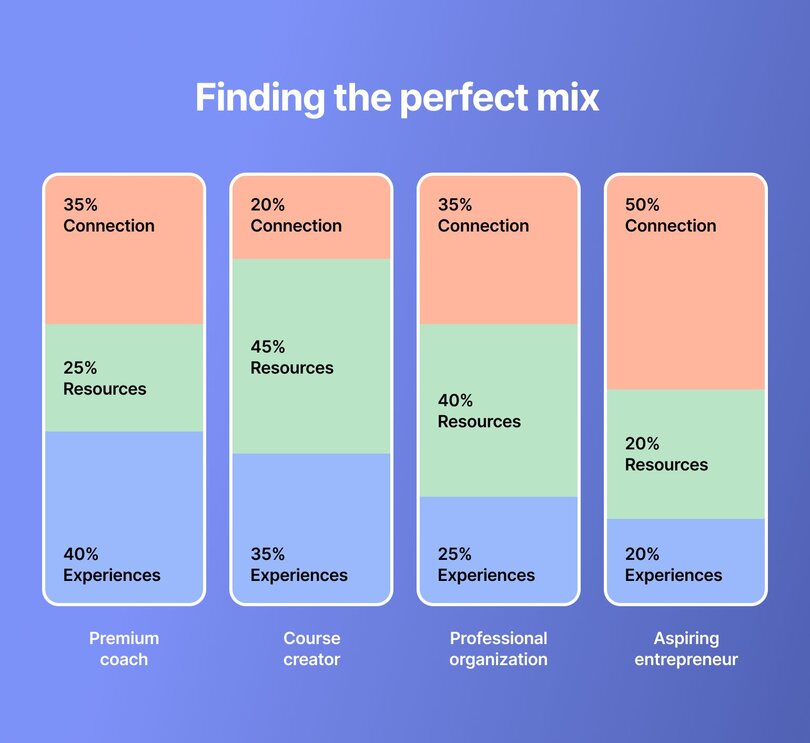
When you’re planning your community’s offering mix, it helps to think about::
- Which category (experiences, resources, connection opportunities) will most effectively allow you to deliver on your community’s promised transformation—and support the transformation your members are looking for?
- How can other categories support your member’s goals in a strategic and intentional way?
Once you’ve put some thought to the above, you should have a much clearer picture of how to balance your offering mix. And from there, you can slot in specific experiences, resources, and connection opportunities (refer back to the ideas above if you’re stuck!) to build out your offering.
To see this in action, let’s take a quick peek at how three real Circle communities have shaped their offerings…
The framework in action: real examples of community offerings
Self-Care Society
Self-Care Society’s offering prioritizes structured experiences, followed closely by resources, and then connection opportunities.
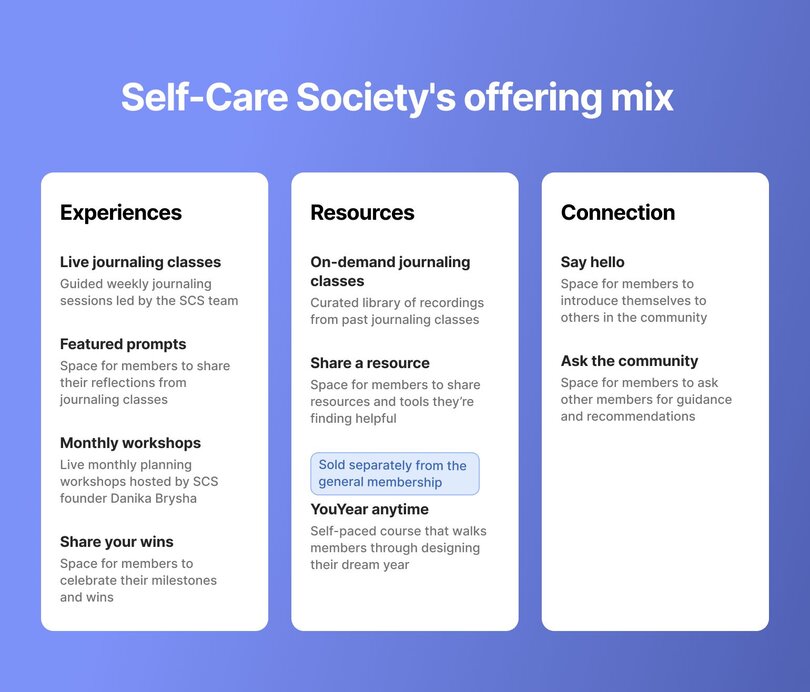
Web Designer Pro
Web Designer Pro’s offering includes a fairly even mix of all three pillars, but leans most heavily into structured experiences and curated resources.
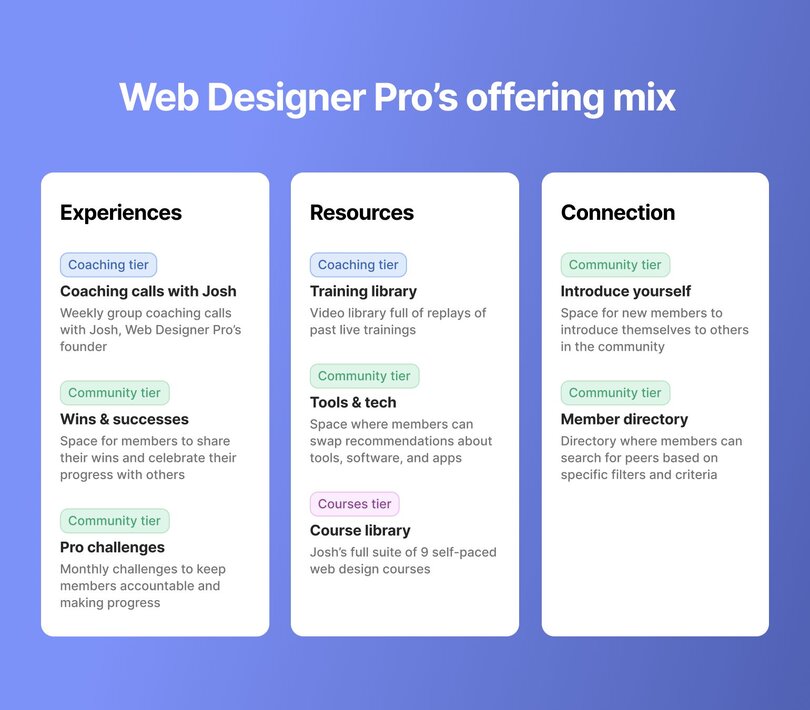
Author Ever After
And Author Ever After’s offering is also pretty balanced across the three pillars, but does lean towards prioritizing structured experiences and connection opportunities.
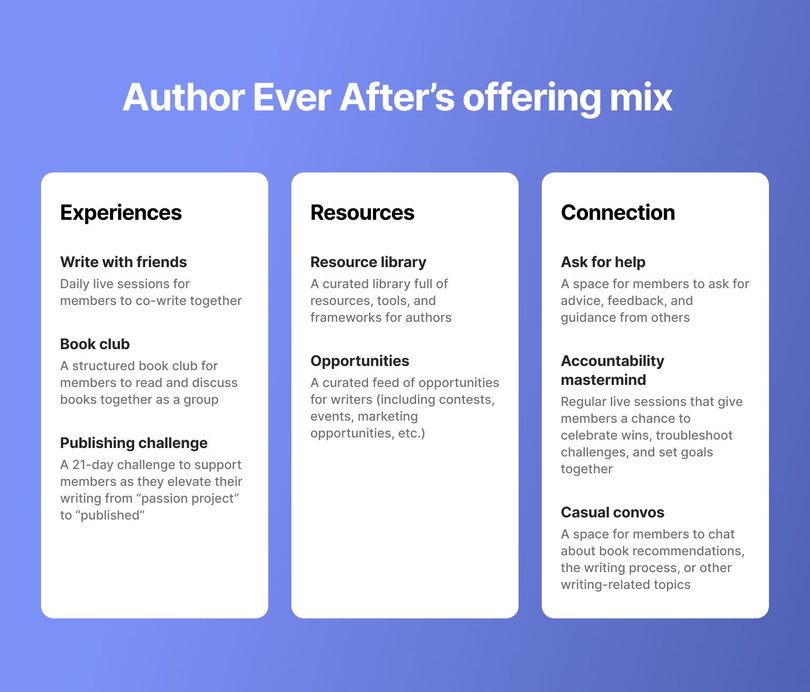
As you can see, each of these communities has a unique offering mix. And while each community includes all three categories in their offering, they prioritize them differently.
If you’re interested in diving deeper into this and looking for more support as you design your offering, be sure to check out the Community Offering course in Circle Academy, which is available to all Circle customers for free.
And as you move forward, keep in mind that your offering is never set in stone. You can and should revisit and refine it over time to better suit members’ needs and expectations.
Because at the end of the day, your community isn’t just a random group of people. It’s a place where meaningful transformation happens, and your offering is what makes that transformation possible. When you design that offering with care, you’ll find that your community truly thrives.